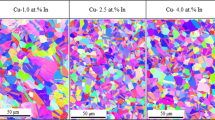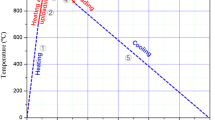Abstract
By electron-beam (e-beam) melting, we prepared 0.4 wt% carbon-infused copper (CuCv4), and a copper control without carbon addition (CuCvO). Scanning electron microscopy and helium ion microscopy (HIM) were performed on the as-solidified surface, fracture surface, and ion-polished surface of the CuCv4 sample. The results revealed that graphitic carbon flakes cover the as-solidified surface, and carbon nanoparticles and clusters exist in the fracture and ion-polished surfaces. HIM on the ion-polished surface revealed a unique ripple-shaped feature, which is possibly associated with the infusion of carbon nanoribbons in the copper matrix. The bulk densities were measured to be 8.86 and 8.53 g/cm3, which correspond to relative densities of 98.9% and 96.4% for the CuCvO and CuCv4 samples, respectively. In addition, apparent electrical conductivities were measured to be 56.9 and 57.5 MS/m, respectively, for the e-beam melted CuCvO and CuCv4 samples. These values correspond to true electrical conductivities of 100.5% IACS (International Annealed Copper Standard) and 107.4% IACS after correction for the porosity. Our results reveal remarkable promise of using covetic copper for the next generation conductors in energy applications from microelectronic devices to high-power transmission cables.






Similar content being viewed by others
References
D. Arentt: Supernovae and Nucleosynthesis (Princeton University Press, Princeton, NJ, 1996).
M.S. Dresselhaus, G. Dresselhaus, and P.C. Eklund: Science of Fullerenes and Carbon Nanotubes (Academic Press, San Diego, 1996).
A. Hirsch: The era of carbon allotropes. Nat. Mater. 9, 868 (2010).
M. Hu, F. Tian, Z. Zhao, Q. Huang, B. Xu, L.M. Wang, H-T. Wang, Y. Tian, and J. He: Exotic cubic carbon allotrope. Phys. Chem. C 116, 24233 (2012).
R. Hoffmann, A.A. Kabanov, A.A. Golov, and D.M. Proserpio: Homo citans and carbon allotropes: for an ethics of citation. Angew. Chem. Int. Ed. 55, 10962 (2016).
A.G. Nasibulin, P.V. Pikhitsa, H. Jiang, D.P. Brown, A.V. Krasheninnikov, A.S. Anisimov, P. Queipo, A. Moisala, D. Gonzalez, G. Lientschnig, A. Hassanien, S.D. Shandakov, G. Lolli, D.E. Resasco, M. Choi, D. Tománek, and E.I. Kauppinen: A novel hybrid carbon material. Nat. Nanotechnol. 2, 156 (2007).
D.R. Forrest, I. Jasiuk, L. Brown, P. Joyce, A. Mansour, and L. Salamanca-Riba: Novel metal-matrix composites with integrally-bound nanoscale carbon. Technical Proceedings of the NSTI Nanotechnology Conference and Expo (NSTI-Nanotech 2012, Santa Clara, CA, June 18-21, 2012, pp. 560, CRC Press 2012).
L. Salamanca-Riba, I. Isaacs, A. Mansour, A. Hall, D.R. Forrest, M.C. LeMieux, and J. Shugart: A new type of carbon nanostructure formed within a metal-matrix. Technical Proceedings of the NSTI Nanotechnology Conference and Expo (NSTI-Nanotech 2012, Santa Clara, CA, June 18-21, 2012, pp. 278, CRC Press 2012).
U. Balachandran, B. Ma, S.E. Dorris, R.E. Koritala, and D.R. Forrest: Nanocarbon-infused metals: A new class of covetic materials for energy applications. Proceedings of the Materials Science and Technology Technical Meeting (MS&T16, Salt Lake City, UT, October 23-27, 2016).
L.G. Salamanca-Riba, R.A. Isaacs, M.C. LeMieux, J. Wan, K. Gaskell, Y. Jiang, M. Wuttig, A.N. Mansour, S.N. Rashkeev, M.M. Kuklja, P.Y. Zavalij, J.R. Santiago, and L. Hu: Synthetic crystals of silver with carbon: 3D epitaxy of carbon nanostructures in the silver lattice. Adv. Funct. Mater. 25, 4768 (2015).
H.M.I. Jaim, R.A. Isaacs, S.N. Rashkeeva, M. Kuklja, D.P. Cole, M.C. LeMieux, I. Jasiuk, S. Nilufar, and L.G. Salamanca-Riba: Sp2 carbon embedded in Al-6061 and Al-7075 alloys in the form of crystalline gra-phene nanoribbons. Carbon. N. Y. 107, 56 (2016).
U. Balachandran, B. Ma, and S.E. Dorris: Method for making metal-carbon composites and compositions. U.S. Patent Application 20180073110A1, published March 15, 2018.
M. Bakir and I. Jasiuk: Novel metal-carbon nanomaterials: a review on covetics. Adv. Mater. Lett. 8, 884 (2017).
B. Ma, J. Wang, T.H. Lee, S.E. Dorris, J. Wen, and U. Balachandran: Microstructural characterization of Al4C3 in aluminum-graphite composite prepared by electron-beam melting. J. Mater. Sci. 53, 10173 (2018).
B. Ma, U. Balachandran, J. Wang, J. Wen, S.E. Dorris, T.H. Lee, and A.J. Rondinone: Structural hierarchy of nanocarbon in copper covetics. Appl. Phys. Lett. 113, 173102 (2018).
ASTM International: Standard test method for resistivity of electrical conductor materials. (ASTM B193, West Conshohocken, PA, 2018).
See, for example, Royal Society of Chemistry website, http://www.rsc.org/periodic-table/element/29/copper.
G.E. Archie: The electrical resistivity log as an aid in determining some reservoir characteristics. Petroleum Trans. AlME 146, 54 (1942).
H. El Khal, A. Cordier, N. Batis, E. Siebert, S. Georges, and M.C. Steil: Effect of porosity on the electrical conductivity of LAMOX materials. Solid State Ionics 304, 75 (2017).
O.F. Boitsov, L.I. Chernyshev, and V.V. Skorokhod: Effect of porous structure on the electrical conductivity of highly porous metal-matrix materials. Powder Metall. Met. Ceram. 42, 88 (2003).
P. Grootenhuis, R.W. Powell, and R.P. Tye: Thermal and electrical conductivity of porous metals made by powder metallurgy methods. Proc. Phys.Soc. B 65, 502 (1952).
Acknowledgment
The authors would like to thank Ms. J. Wang, Dr. J. Wen, Mr. B. L. Fisher, and Dr. R. E. Koritala in the Nanoscience and Technology Division, Ms. S. J. Lopykinski and Dr. D. G. Graczyk in the Chemical and Fuel Cycle Technology Division at Argonne National Laboratory for their technical assistance and discussion. This work was supported by the US Department of Energy (DOE), Energy Efficiency and Renewable Energy, Advanced Manufacturing Office, under Contract No. DE-AC02-06CH11357. Use of the Center for Nanoscale Materials, an Office of Science user facility, was supported by the US Department of Energy, Office of Science, Office of Basic Energy Sciences, under Contract No. DE-AC02-06CH11357. Helium ion microscopy was conducted at the Center for Nanophase Materials Sciences at Oak Ridge National Laboratory, which is a DOE Office of Science User Facility. The submitted manuscript has been created by UChicago Argonne, LLC, Operator of Argonne National Laboratory (“Argonne”). Argonne, a US Department of Energy Office of Science laboratory, is operated under Contract No. DE-AC02-06CH11357. The US Government retains for itself, and others acting on its behalf, a paid-up nonexclusive, irrevocable worldwide license in said article to reproduce, prepare derivative works, distribute copies to the public, and perform publicly and display publicly, by or on behalf of the Government.
Author information
Authors and Affiliations
Corresponding author
Rights and permissions
About this article
Cite this article
Ma, B., Balachandran, U., Dorris, S.E. et al. Preparation and electrical conductivity of graphitic carbon-infused copper alloys. MRS Communications 9, 137–143 (2019). https://doi.org/10.1557/mrc.2019.12
Received:
Accepted:
Published:
Issue Date:
DOI: https://doi.org/10.1557/mrc.2019.12




